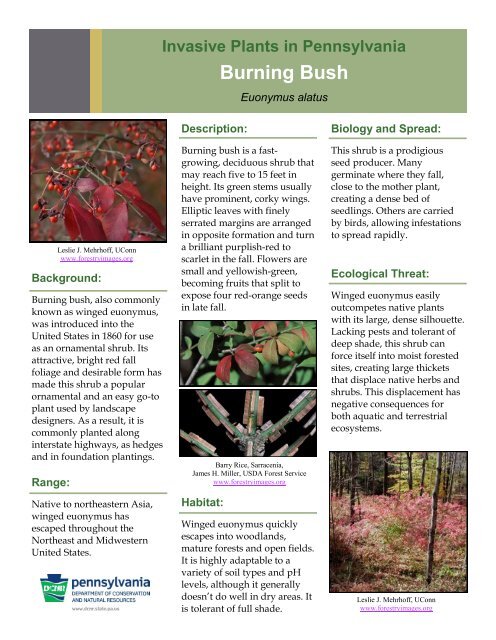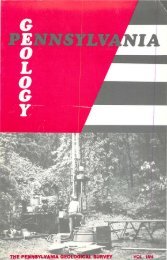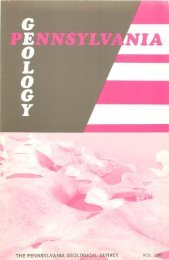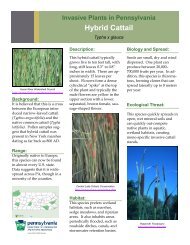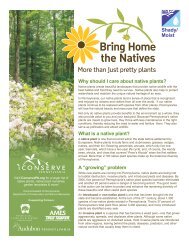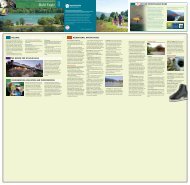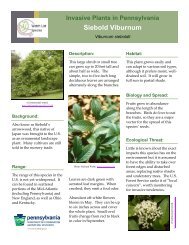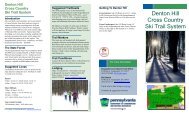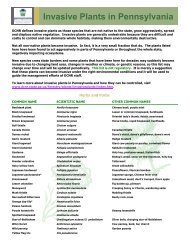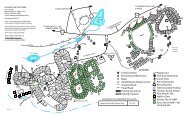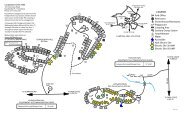Winged euonymus or Burning-bush
Winged euonymus or Burning-bush
Winged euonymus or Burning-bush
Create successful ePaper yourself
Turn your PDF publications into a flip-book with our unique Google optimized e-Paper software.
Background:<br />
<strong>Burning</strong> <strong>bush</strong>, also commonly<br />
known as winged <strong>euonymus</strong>,<br />
was introduced into the<br />
United States in 1860 f<strong>or</strong> use<br />
as an <strong>or</strong>namental shrub. Its<br />
attractive, bright red fall<br />
foliage and desirable f<strong>or</strong>m has<br />
made this shrub a popular<br />
<strong>or</strong>namental and an easy go-to<br />
plant used by landscape<br />
designers. As a result, it is<br />
commonly planted along<br />
interstate highways, as hedges<br />
and in foundation plantings.<br />
Range:<br />
Leslie J. Mehrhoff, UConn<br />
www.f<strong>or</strong>estryimages.<strong>or</strong>g<br />
Native to n<strong>or</strong>theastern Asia,<br />
winged <strong>euonymus</strong> has<br />
escaped throughout the<br />
N<strong>or</strong>theast and Midwestern<br />
United States.<br />
Invasive Plants in Pennsylvania<br />
Description:<br />
<strong>Burning</strong> Bush<br />
Euonymus alatus<br />
<strong>Burning</strong> <strong>bush</strong> is a fastgrowing,<br />
deciduous shrub that<br />
may reach five to 15 feet in<br />
height. Its green stems usually<br />
have prominent, c<strong>or</strong>ky wings.<br />
Elliptic leaves with finely<br />
serrated margins are arranged<br />
in opposite f<strong>or</strong>mation and turn<br />
a brilliant purplish-red to<br />
scarlet in the fall. Flowers are<br />
small and yellowish-green,<br />
becoming fruits that split to<br />
expose four red-<strong>or</strong>ange seeds<br />
in late fall.<br />
Barry Rice, Sarracenia,<br />
James H. Miller, USDA F<strong>or</strong>est Service<br />
www.f<strong>or</strong>estryimages.<strong>or</strong>g<br />
Habitat:<br />
<strong>Winged</strong> <strong>euonymus</strong> quickly<br />
escapes into woodlands,<br />
mature f<strong>or</strong>ests and open fields.<br />
It is highly adaptable to a<br />
variety of soil types and pH<br />
levels, although it generally<br />
doesn’t do well in dry areas. It<br />
is tolerant of full shade.<br />
Biology and Spread:<br />
This shrub is a prodigious<br />
seed producer. Many<br />
germinate where they fall,<br />
close to the mother plant,<br />
creating a dense bed of<br />
seedlings. Others are carried<br />
by birds, allowing infestations<br />
to spread rapidly.<br />
Ecological Threat:<br />
<strong>Winged</strong> <strong>euonymus</strong> easily<br />
outcompetes native plants<br />
with its large, dense silhouette.<br />
Lacking pests and tolerant of<br />
deep shade, this shrub can<br />
f<strong>or</strong>ce itself into moist f<strong>or</strong>ested<br />
sites, creating large thickets<br />
that displace native herbs and<br />
shrubs. This displacement has<br />
negative consequences f<strong>or</strong><br />
both aquatic and terrestrial<br />
ecosystems.<br />
Leslie J. Mehrhoff, UConn<br />
www.f<strong>or</strong>estryimages.<strong>or</strong>g
How to Control this<br />
Species:<br />
Physical<br />
Seedlings, up to two feet tall,<br />
can be easily hand-pulled,<br />
especially when the soil is<br />
moist.<br />
Larger plants must be dug<br />
out with a spading f<strong>or</strong>k,<br />
pulled with a weed wrench,<br />
<strong>or</strong> cut. The stump must be<br />
ground out <strong>or</strong> the re-growth<br />
clipped; be sure to remove a<br />
maj<strong>or</strong>ity of the root system.<br />
Chemical<br />
Glyphosate can be applied as<br />
a foliar spray <strong>or</strong> painted on<br />
cut stumps.<br />
Look-A-Likes:<br />
<strong>Winged</strong> euonymous may be<br />
confused with other species of<br />
euonymous, including our<br />
native strawberry <strong>bush</strong><br />
(Euonymus americana). Saplings<br />
of native sweetgum<br />
(Liquidambar styraciflua) also<br />
have winged stems.<br />
Strawberry Bush<br />
Karan A. Rawlins, University of Ge<strong>or</strong>gia<br />
www.f<strong>or</strong>estryimages.<strong>or</strong>g<br />
Native Alternatives:<br />
A wide variety of native<br />
shrubs provide beauty and<br />
wildlife value to the<br />
landscape, including:<br />
Red Chokeberry<br />
Witch-hazel<br />
Dow Gardens<br />
www.f<strong>or</strong>estryimages.<strong>or</strong>g<br />
Chris Evans, River to River CWMA<br />
www.f<strong>or</strong>estryimages.<strong>or</strong>g<br />
References:<br />
Center f<strong>or</strong> Invasive Species and Ecosystem Health:<br />
http://www.invasive.<strong>or</strong>g/browse/subinfo.cfm?sub=3023<br />
U.S. National Park Service: http://www.nps.gov/plants/alien/<br />
pubs/midatlantic/eual.htm<br />
F<strong>or</strong> M<strong>or</strong>e Inf<strong>or</strong>mation:<br />
Ninebark<br />
Common Winterberry<br />
Rob Routledge, Sault College<br />
www.f<strong>or</strong>estryimages.<strong>or</strong>g<br />
Vern Wilkins<br />
www.f<strong>or</strong>estryimages.<strong>or</strong>g<br />
Virginia Sweetspire<br />
James Miller & Ted Bodner, SWSS<br />
www.f<strong>or</strong>estryimages.<strong>or</strong>g<br />
DCNR Invasive Species Site: http://www.dcnr.state.pa.us/<br />
conservationscience/invasivespecies/index.htm<br />
DCNR Invasive Exotic Plant Tut<strong>or</strong>ial f<strong>or</strong> Natural Lands Managers:<br />
http://www.dcnr.state.pa.us/f<strong>or</strong>estry/invasivetut<strong>or</strong>ial/<br />
winged_<strong>euonymus</strong>.htm


